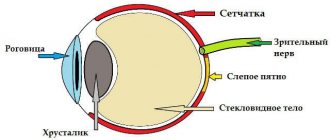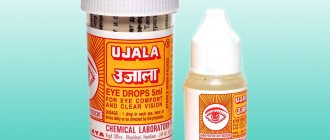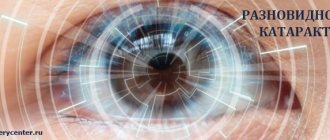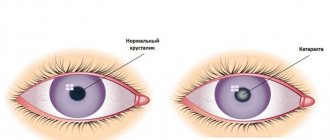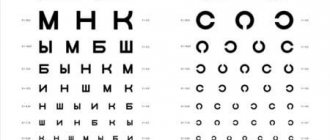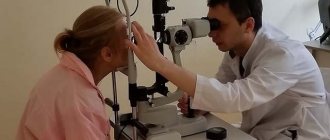Yana Khvatova Health August 08, 2019
Only on the website
An ophthalmologist explains how to preserve your vision.
Image by Rudy and Peter Skitterians from Pixabay
August 8 is International Ophthalmology Day. In the 21st century, almost every second person faces the problem of eye diseases. This is due to changes in the rhythm of life, hard work and many other factors. If you do not pay attention to dangerous symptoms in time, advanced stages of the disease can lead to partial loss of vision or even complete blindness. Ophthalmologist Yuri Korotkikh told St. Petersburg Vedomosti what signs can be used to identify the most common eye diseases.
Conjunctivitis
Conjunctivitis is one of the most unpleasant eye diseases. Of course, you cannot go blind from simple inflammation of the mucous membrane, but if the disease is not treated, it can become chronic. The disease is unpleasant: the eyes water, become inflamed, and itch. In some cases, conjunctivitis can be a consequence of a cold, but it is often called the disease of dirty hands. “To avoid becoming a victim of this disease, never rub your eyes with dirty hands - after touching handrails in public transport, door handles, money
, advises the doctor.
“ Infection can easily enter the mucous membrane
.
If you still did not follow the rules of personal hygiene and contracted conjunctivitis, then its characteristic signs will appear very soon. It all starts with a slight burning sensation and a feeling of “sand in the eyes.” Then the eyelids begin to itch and swell. The eyes become red, watery, and a thick liquid is released from them. If you consult a doctor immediately after these symptoms appear, you can get rid of the disease in a few days.
Blepharitis
Related article:
One chance operation. In St. Petersburg, doctors successfully transplanted a liver to a patient for the first time
Blepharitis is also an infectious disease, but it is much more difficult to treat. With this disease, the edges of the eyelids become inflamed, and the course of therapy lasts more than a month.
“There are many factors that can trigger the development of this disease,
- says Korotkikh.
— These include various infections, allergies, diseases of the digestive tract or nasopharynx, dirt or dust getting into the eyes.
Blepharitis can even develop from a lack of vitamins. And a relapse of the disease indicates a person’s low immunity .
With blepharitis, the eyelids begin to swell and their edges become red. Soon a scaly crust forms under the eyelashes. As a rule, the process is accompanied by itching and loss of eyelashes. At the same time, the eyes water and become hypersensitive to wind and other external factors.
The doctor warns that blepharitis can easily be confused with conjunctivitis: the correct diagnosis can only be made in a medical facility.
Keratoconjunctivitis sicca (dry eye syndrome)
Dry eye syndrome is a condition in which the tear film on the eyeball stops repairing itself. As a result, a person feels pain, eye irritation, and constant discomfort. If this disease is not treated, vision will gradually deteriorate.
Previously suffered other eye diseases, age-related changes in the body, and hereditary predisposition can lead to the appearance of a dangerous syndrome.
It is necessary to visit an ophthalmologist twice a year. Photo: Pixabay/jasongillman
The main symptoms of the disease are a persistent feeling of tired eyes, redness, and itching. The eyes periodically begin to water for no reason, objects seem blurry: it is difficult to focus your gaze. “These signs usually become pronounced after the patient has spent a lot of time at the computer, reading, watching TV - that is, straining his eyes,
- explains the doctor.
“ Therefore, if after a working day at the computer the picture in front of your eyes has lost clarity, this is a reason to seek medical help
.
Glaucoma
Glaucoma is a very dangerous disease that can lead to complete loss of vision. It affects women more often than men, as well as people over 50 years of age, but this disease can also be congenital.
Related article:
Doctors told how to avoid getting hepatitis in a beauty salon
With glaucoma, the outflow of intraocular fluid decreases, which leads to atrophy of the optic nerve. A person's vision becomes worse and worse and without proper treatment he may become partially or completely blind. The disease usually develops due to increased pressure inside the eye.
In the initial stages, the eyes begin to hurt, surrounding objects seem as if in a fog. The eyeballs become “heavy” and hurt. As the disease progresses, vision gradually deteriorates. At first, a person sees poorly in the twilight, then the field of vision narrows. A cloudy film appears on the cornea.
“The sooner you see a doctor for these symptoms, the better,”
- advises the ophthalmologist.
— It is impossible to restore the damaged optic nerve and improve vision with glaucoma.
But the necessary therapy will stop the process of nerve destruction, and vision will stop deteriorating .
Cataract
Cataract is clouding of the lens of the eye. This disease can be caused by other concomitant diseases, eye injuries, and an unfavorable environment. Typically, the risk of developing cataracts increases after age 50. Elderly people - over 70-80 years old - are especially susceptible to it.
With this disease, a person’s vision becomes blurred, and the pupil changes color: it becomes whitish or grayish. The eyes get tired quickly, the patient cannot tolerate bright light. A clearly defined cloudy film appears on the lens of the eye.
The only effective treatment for cataracts today is lens replacement surgery. After this, the patient can immediately return to normal life without any restrictions. It is impossible to cure cataracts with medications or ointments.
Many eye diseases are preventable. Photo: Pixabay/andreas160578
To prevent eye diseases, the doctor recommends regularly performing simple procedures - performing eye exercises every two to three hours of working at the computer, making compresses with black, green tea or chamomile tea at least once a month, and visiting an ophthalmologist twice a year.
#diseases #health #doctor's advice
Share on VKontakte Facebook
Cool
What it is
Glaucoma is a group of many different diseases of the visual organs. At the last stage, the pupil becomes motionless, always dilated and has a characteristic greenish color. The name comes from Greece and has a translation - azure or sea green; glaucoma is also sometimes called “green cataract” and “green water”.
Glaucoma is a chronic visual disorder. Expressed by increased pressure inside the eyeball. This indicator can occur periodically and chronically. In the optic nerve and retina of the eyes, a violation of the outflow of intraocular fluid develops. This provokes the occurrence of visual defects.
More than 60 different diseases are combined under the general name “glaucoma,” but they have some similar characteristics:
- Intraocular pressure (IOP) is above the norm of personal tolerance for this indicator. Both temporary and chronic impairments are included.
- Impairs the functioning of the optic nerve. This disorder is also called glaucomatous optic neuropathy, which causes atrophy of the optic nerve.
- All have similar visual impairments that are unique to glaucoma.
The disease is not always provoked by age-related changes in the body and can even be congenital.
The congenital indicator is very low and increases with age. The highest rate is among older people.
Types of glaucoma
Glaucoma comprises a large group of diseases, but is mainly divided into three types: congenital, primary and secondary. These are different pathological conditions, but the boundary between them in practice is sometimes arbitrary and it is not always possible to differentiate them. In secondary glaucoma, an increase in IOP is a consequence of damage or other diseases of the eye (iridocyclitis, uveitis, circulatory disorders in the vessels of the eye, orbit, intraocular hemorrhages, retinopathy, in particular diabetic, etc.) Congenital glaucoma in most cases manifests itself immediately after birth or during the first year of a child's life. Its development is based on various anomalies of the eye drainage system of a hereditary nature or associated with pathological conditions of a woman during pregnancy (measles, rubella, influenza, poisoning, etc.).
Causes
Unfortunately, there is no definite opinion on what causes glaucoma. It is generally accepted that this is a multifactorial disease, has several stages and each of them introduces its own irreversible changes. To this deviation. People with individual anomalies in the structure of the eyes, who have various pathologies in the nervous system, endocrine, and cardiovascular systems are at risk, and there is also a risk of inheriting this disease.
Angle-closure glaucoma
Scientists are not yet able to study why exactly certain disorders occur during the development of glaucoma, but it is clear how certain disorders affect eye health and cause new problems. Most often the disease progresses in this way:
- The outflow of intraocular fluid is disrupted. Even a simple inflammatory process can cause this problem.
- The consequence of this disorder is increased intraocular pressure.
- Blood circulation in the tissues of the organs of vision worsens.
- Oxygen starvation begins to develop, and the blood supply to the tissues of the visual organs located at the exit of the optic nerve is disrupted.
- The nerve fibers in the eyeball are compressed. Because of this, their functioning is disrupted and they begin to collapse.
- Due to metabolic disturbances in the cells of the eyeball, the visual fibers atrophy and some cells of the retina disintegrate.
- The rapid development of glaucomatous optic neuropathy, due to which the optic nerve dies.
Open angle glaucoma
At almost any stage, it is possible to prevent the development of the disease, provided that the treatment regimen prescribed by the doctor is followed. The effectiveness of treatment depends on the degree of changes in the visual organs that have already occurred. It is not possible to restore lost eye functions; doctors can only stop the subsequent development of the disease.
Symptoms
The main danger of glaucoma is that at the initial stage it is asymptomatic. Patients go to the hospital after obvious disturbances in the organs of vision, but it is no longer possible to restore the damage.
It is quite difficult to assume the occurrence of glaucoma on your own, but if you notice that your peripheral vision has narrowed, you should immediately contact an ophthalmologist. Primary symptoms also include the appearance of “rainbow circles” when looking at light sources and painful sensations in the eyes. Visual acuity often remains without deterioration.
If you have a family history of eye health problems, never skip routine eye exams! Only a specialist can detect glaucoma in the early stages!
Quite often, people are unaware of the development of glaucoma until its acute attack. The attack is accompanied by a sudden decrease in visual acuity or blurring, sharp pain in the eyes, the appearance of halos when looking at light sources, and severe headache. There may even be nausea or vomiting. If you feel any of these symptoms, you must go to the hospital immediately! Only prompt ophthalmological care gives a chance to preserve vision. Blindness due to glaucoma is irreversible!
Increased intraocular pressure
Glaucoma and COVID-19
Coronavirus protection guidance for people with eye conditions
Coronavirus Guide for Eye Patients
Developed by the American Academy of Ophthalmology (San Francisco County, California, USA)
The original text is available here.
The world's largest association of eye doctors and surgeons working to protect and improve the lives of people with visual impairments, meeting the needs of the times and following the principles of the patient education policy, distributed from spring to autumn of this year a selection of current articles, which together constituted a guide for people suffering from diseases eyes, during the coronavirus pandemic. Articles by Academy specialists have been added to this Guide as they were written, starting from the beginning of the pandemic. They contain information about the risks of coronavirus infection to the eyes and advice to patients and all citizens forced to stay at home on how to protect their eyes from infection.
The translation does not include sections on gene therapy for blindness and antimalarial drugs in the treatment of coronavirus infection in the first part, as well as two general sections in the second part of the Guide, due to the large volume of the document.
All positions discussed in the Guide accompany the lives of patients with glaucoma, so the advice given is of practical value for them. It should be borne in mind that semantic repetitions in the texts of sections are inevitable in regulatory documents, and treat this with understanding.
Diagnostics
Despite the fact that the main indicator of the development of glaucoma is increased intraocular pressure, only measuring IOP is not enough to diagnose this disease. This requires a number of studies and tests:
- Use specialized equipment to examine the patient’s field of vision.
- Test the ability of the eyes to refract optical rays.
- Measure IOP.
- Conduct an ultrasound of the visual organs.
- Determine the depth of the anterior chamber of the eyes and the thickness of the lenses.
- To study the structure of the anterior chamber of the eye, where the outflow of intraocular fluid occurs.
- Examine the intraocular fundus.
To get accurate results, a mandatory visit to the clinic is necessary. Only an experienced specialist will be able to conduct all the necessary studies and prescribe the necessary treatment. Do not forget that the primary development of glaucoma cannot be detected independently, and the disorders that it causes cannot be reversed!
Symptoms of glaucoma
Compresses
A large number of different recipes are used as compresses:
- Aloe is a very beneficial plant for the eyes. A mixture is prepared from it and used as an ointment, applied with gauze or a napkin to the eyes. You should take the leaves of the plant, chop them and pour boiling water over them. Leave for three hours, then strain and use as an ointment three times a day.
- Treatment with raw potatoes and apple cider vinegar. Grate the potatoes and dilute with a small amount of vinegar so that the mass is not too thick. Apply this product to your eyelids and the area near your eyes. Leave for at least half an hour.
- Make an infusion of rose hips. After soaking the napkin in the liquid, place it on your closed eyes. Do this several times a day. Pour the decoction for compresses into a separate container, and drink the rest instead of tea.
- You can make lotions from golden mustache by pouring boiling water over it and letting it sit for several hours.
Treatment
It is impossible to completely cure glaucoma. You can only prevent or slow down its development. There are 2 main methods of treatment: conservative and surgical.
Treatment of glaucoma with drops
Conservative treatment mainly uses medications. Most often these are anti-glaucoma drops that improve the outflow of intraocular fluid, thereby reducing IOP. In the initial stages of disease development, they are a very effective method, but abandoning them leads to a sharp relapse. It is impossible to completely cure glaucoma with drops, and only open-angle glaucoma can be effectively treated. At this stage, characteristic changes in the structure of the visual organs have not yet occurred. The drops will have to be used throughout your life to prevent the disease from developing. Angle-closure glaucoma is practically not amenable to conservative treatment.
Surgery is more effective as a treatment method. But it does not eliminate the disease forever. Glaucoma surgery is performed on the eye if there is a risk of complete loss of vision. During the operation, new pathways are formed for the removal and movement of intraocular fluid, thereby reducing intraocular pressure. However, this effect is also temporary. Yes, after a long time, but still the disease returns due to narrowing or overgrowth of new channels.
Treatment is prescribed by a doctor, and the method depends on the form of the disease. By following all the doctor's instructions, the disease will not bother you. You should not skip routine examinations to prevent the condition from worsening, and if you experience any discomfort, you should immediately visit the clinic.
Complications
Having started the disease, the patient will almost certainly completely lose vision and it will no longer be possible to restore it. The sooner treatment begins, the fewer irreversible processes can be prevented. Also, in order not to provoke the development of the disease, it is advisable to follow a special diet prescribed by the attending physician.
Remember that the worst complication of glaucoma is complete loss of vision without the possibility of recovery!
Complications of glaucoma: damage to the iris
Prevention
To avoid the development of this disease, it is necessary to visit an ophthalmologist in a timely manner for routine examinations. Be sure to treat any diseases of the organs of vision. This is especially true for any injuries and cataracts. Be attentive to any changes in the lens and any pathology must be eliminated immediately.
A balanced diet rich in essential elements will also help. The diet must include protein foods. Light physical activity that stimulates proper blood circulation in the body. Including in the organs of vision, preventing oxygen starvation. But to prevent a sharp increase in intraocular pressure, you should avoid lifting heavy objects.
Symptoms of retinal detachment - everyone should know about this!
What is amblyopia and how often does it occur in adults, read this article.
Erosion of the cornea of the eye: https://eyesdocs.ru/zabolevaniya/eroziya-rogovicy-glaza/chem-opasna-boleznj.html
It will help...beer!
I have glaucoma. What to do to preserve your vision longer?
Dmitry, Lipetsk
– Do not skip using eye drops, visit your doctor regularly and monitor intraocular pressure.
It is also worth sticking to a certain diet. You need to eat less meat, bread, fried, smoked, salted. Vitamins are important, especially A, C, E. Foods containing flavonoids, such as dark chocolate, are useful.
Article on the topic
“Laser correction is not for everyone.” Doctor about myths around eye diseases Coffee and strong tea are not recommended for patients with closed-angle glaucoma. But for open-angle glaucoma, they are useful in small quantities. They are rich in polyphenols - free radical scavengers. But it is only advisable that the ophthalmologist first conduct a test: measure the intraocular pressure before two cups of tea or coffee and an hour and a half after drinking them, find out whether they increase the pressure.
If a patient has undergone surgery due to glaucoma and the surgeon has recommended drinking non-alcoholic beer, then you should not be surprised. Beer increases the secretion of intraocular fluid. In some situations, this is necessary to prevent choroidal retinal detachment.
Treatment of glaucoma without surgery using folk remedies and methods: recipes, recommendations
Treatment of glaucoma without surgery using folk remedies and methods
Herbal decoctions and infusions are always popular in the treatment of any disease, and glaucoma is no exception. After all, many medicines contain extracts from plants. However, the treatment prescribed by the doctor should not be ignored. In addition to it, you can use folk remedies and methods. Here are recipes and recommendations for treating glaucoma without surgery:
A decoction of motherwort - this ancient plant is a good helper in the treatment of glaucoma. To prepare a medicinal decoction, do the following:
- Pour a tablespoon of dried raw material into a glass of boiled water and let it brew for one hour.
- After this, strain the infusion through multilayer gauze.
- Use motherwort medicine three times a day, 1 tablespoon for 1 month.
Nettle infusion - this plant can be used to treat glaucoma, as it is equipped with various vitamins and nutrients. The recipe for a medicinal infusion of nettles is simple. To prepare the medicine, do the following:
- Finely chop the nettle leaves.
- Pour 1 tablespoon of crushed leaves into 200 ml of hot water.
- Then the broth should be infused for 1.5 hours.
- Take this folk medicine from nettle 150 ml 3 times a day.
A decoction of dill seeds contains many useful substances that can be used to treat glaucoma. For the decoction you need to do the following:
- Pour 2.5 teaspoons of dill seeds into 500 ml of settling water and boil for 15 minutes.
- After this, remove the broth from the stove and let it brew for 1.5 hours.
- Now the medicinal infusion should be filtered.
- Take the resulting drug orally, 50 ml three times a day, 30 minutes before meals.
- Treatment lasts for one month.
These are the most basic medicinal infusions and decoctions that are most often used by patients with glaucoma. You can also prepare the medicine with aloe juice, flaxseeds, honey and others.
Does glaucoma affect one eye or both?
Typically starts with one eye. The pressure in the other eye is normal. Over time, glaucoma joins the other eye, but usually does not start at the same time. There are patients in whom glaucoma begins simultaneously in both eyes, then the situation is worse. As a rule, people do not come very early with this disease, because the patient does not show any complaints at the development stages. He has good eyesight, and not all people can notice the narrowing of the field of view.
There is closed glaucoma, where the angle is anatomically narrow, and due to a complex of factors, this angle is completely blocked. This is called an acute attack of glaucoma, when the pressure rises sharply. Then irritation occurs due to high pressure, and the patient experiences pain. It can be perceived by the patient as a headache, migraine, heart attack, back pain between the shoulder blades, because it radiates anywhere.
The pain may not be directly localized to the eye. Therefore, sometimes even an ambulance takes a patient and says that he has a pre-infarction condition or a hypertensive crisis. Patients end up in therapy, in cardiology. And there it is revealed that it is neither one nor the other, and the patient is assigned to an ophthalmologist. An acute attack is usually a pressure of more than 40 mmHg. If a patient spends more than 3 days with this pressure, the optic nerve may die. This is blindness, an irreversible loss of vision when nothing can be done.
We recently had a patient who suffered an acute attack of glaucoma; the treatment was not entirely adequate, the reduction in intraocular pressure was not entirely complete. In addition, she also had a cataract, which was partially provoked by an acute attack, she had a hypermetropic eye, the outflow system was corresponding. This all led to a complex of factors that caused glaucoma. She came to us in a post-attack state. The attack was not completed, the pressure was not sufficiently reduced. On the other eye the situation developed according to the same picture. We urgently operated on the patient, replaced the lenses with artificial ones, and restored the normalization of the intraocular fluid and its circulation. Due to these changes, we practically did not return central and peripheral vision to this patient due to the fact that for quite a long time before the attack, the pressure put pressure on the optic fibers and destroyed the optic nerve irrevocably. And now the picture of the eye is quite calm, visual function is almost impossible to restore, the vessels that run along the fundus of the eye practically do not supply blood to the retina. She sees 10/100% and has a tubular field of vision. In fact, the patient looks as if through a pipe.
This is a real example of what can result from neglecting a doctor’s advice or untimely provision of medical care or insufficient patient responsibility. One of the main reasons for poor therapy or incorrect attitude towards the disease is that all people compare any disease with a common cold. This applies only to colds, and only in childhood, but in the modern understanding, even a cold is dangerous, various complications can arise, and those systems will be damaged, which will then torment a person for the rest of his life. Diseases must be treated very responsibly, especially those that cause significant damage in the patient’s later life. Be it a functional plan: arms, legs, head after a stroke, eyes, which allow us to do everything. You shouldn’t think that tomorrow it will get better, and the day after tomorrow everything will go away, you need to immediately consult a doctor. And if the doctor has prescribed treatment, then it must be followed scrupulously. If you are unsure about the treatment or the doctor, you should go to another specialist and consult with him. If you still have questions, please clarify them. But if treatment is prescribed by a doctor, it must be carried out accurately and in a timely manner.
Can we cure the disease at the last stage?
Today's surgeries and medications are so effective that stage 4 (terminal) glaucoma is extremely rare. In this situation, doctors can do little to help. After all, if the eye no longer sees, then the optic nerve has completely died. This is part of the visual analyzer - the picture does not enter the brain and the person will never be able to see again.
Therefore, if vision is completely lost, treatment is useless and we can only talk about disability.
In rare cases, there is a painful form of glaucoma, when the affected eyeball constantly hurts greatly. Then doctors perform the only possible operation - they remove the blind eye and install a prosthesis in its place.
New cases of glaucoma are detected annually during preventive examinations. Previously, little attention was paid to it, which is why you can hear about old people going blind due to glaucoma. Today, people with high intraocular pressure, which was detected in a timely manner, live and work successfully. But timely diagnosis is important. If you are over 40 years old and have blind elderly relatives in your family, contact your ophthalmologist to measure your blood pressure!


